|
DECATUR has left few
reminders of the early days, but some remained until comparatively
recent years and are still remembered by many citizens. The old
covered bridge, the type that now has almost entirely disappeared,
crossed the Sangamon where the county bridge now crosses the lake
near the impounding dam. It was probably the first bridge
built in the county, for it was on an important road, the road to
Shelbyville, which intersected the old Springfield-Paris road south
of Decatur. All travel from the south, the east or the west,
came by these roads. No doubt Abraham Lincoln crossed
the Sangamon, at the point where the old covered bridge afterwards
was built, when he came to Macon county in 1830. The exact year of
its erection is not known, but it stood for nearly sixty years.
It was a good bridge in its day, and though built of wood, outlasted
many iron bridges. The old bridge was replaced by a new bridge in
1913. The new bridge was raised 14 feet and new approaches
built, in 1921, when Lake Decatur was formed.
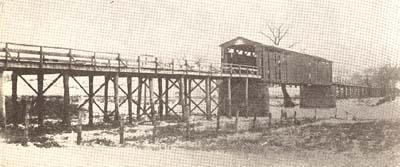
OLD COVERED BRIDGE
CAPTAIN ALLEN HOME The last home of Captain David L. Allen
on the bluff of Allen's bend of the Sangamon stood for years after
the death of Captain Allen to remind one of the genial old
gentlemen who did so much for Decatur. With its eight sided
tower lifting its head above it, the building never failed to
attract attention. It was near where the Mueller lodge now is.
Cap. Allen bought the original 40 acres of his land along the
river, in 1865, and later he erected the house in which he spent his
declining years, having disposed of his house on the east side of
Water street, north of North.
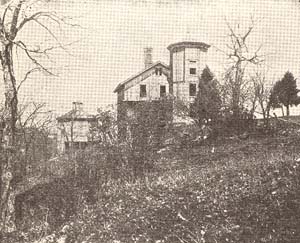
ALLEN'S HOME AT ALLEN'S BEND The
Muellers bought the last of the Allen estate (then
about 70 acres) after Laura, daughter of Captain Allen, died.
That was the beginning of the Mueller holdings south of the river.
Captain Allen built the octagonal tower, it was said, for an
apiary. Allen's bend in the river is no more, since the
creation of the lake, but mention of it brings to many the memory of
moonlight boat rides on the quiet waters of the Sangamon.
DRUG STORE CORNER One of Decatur's landmarks is the store building
now occupied by West's drug store. That corner has been the
location of a drug store since away back in the '40s.
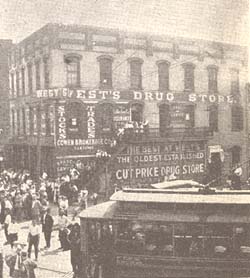
WEST DRUG STORE CORNER In the
building which first occupied that corner William Cantrill
established a general store in 1833. He was there until 1844,
and during several years of that time served as postmaster. In
1844 Crissey & Deffenbach established a drug store
there. Mr. Crissey later became the sole owner, and
moved his stock to another location. Then a tailor shop
occupied the room. Herbert & Potter, physicians,
had their office there next, and they were followed by Dr.
Baldwin. In 1852 Dr. James F. Roberts established a
drug store on the corner, and a drug store has been there ever
since. He bought the site from William Prather May 19,
1857, and in 1861 erected the brick building which still stands.
Dr. Roberts ran the store many years, then sold to W. C.
Armstrong, who in turn, sold to E. A. West, the present
proprietor, in 1892. Three proprietors in a period of
seventy-eight years is remarkable. The Roberts store became
a general meeting place. Mr. Roberts was jolly and
affable and made many friends. The store for many years had an
outside stairway with balcony at the second floor, and from this
balcony war bulletins, proclamations and announcements of any public
nature were made. Lowber Burrows read most of the Civil
war dispatches. Sometimes John Moreland, court crier,
took his place. It was literally true that Moreland
could be heard all over town, for he had a big voice and the town
wasn't very large. For many years all levels in the city were
taken from the door sill of the West drug store.
Engineers set their instruments on the iron door sill at the front
of the building, when they wanted to take levels for street grading
and paving. The old iron stairway and balcony were removed in
1912. Mr. West has in his possession an old prescription
book used in the store in years gone by. Prescriptions for
some of the leading business men of the city appear in that book.
Among them are the following:
Ayers
LeForgee's Hair Tonic
Dinges Blood Purifier
Dingman's Diarrhea Medicine
Powers Liniment
Warnick's Liniment |
|
O. B. Gorin's
Pills
Cologne for Mueller
Dr. Parker's Cholera Remedy
Packard's Eye Wash
Brown Dye for Mr. Millikin |
CASSELL'S CASTLE Cassell's Castle on
Cassell's
hill, long a landmark in Decatur, was erected in 1886 by Berry H.
Cassell. It contained twenty-two rooms, finished in
hardwood, and was one of the finest homes in the neighborhood.
It stood on the hill between the Illinois Central railroad and
Hilton street, near Prairie, which now contains a huge I. P. L. gas
tank. [Sharon Wick's NOTE: My
grandmother made a notation in this book at this point: 'was
mother's guardian'] It was on the site of
this residence that Richard J. Oglesby made his first
political speech in 1842. The occasion was a Fourth of July
celebration and Oglesby was one of the orators of the day.
Henry Elliott read the Declaration of Independence. The
hill at that time was covered with trees.
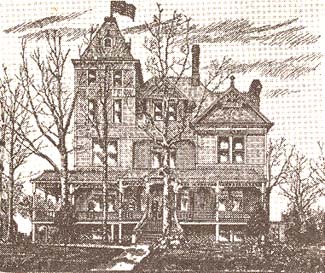
CASSELL'S CASTLE The
Cassell house was destroyed by fire in 1915 and was not rebuilt.
COTTONWOOD TREE Most everyone remembers the old cottonwood tree
which stood in the middle of the Bloomington road, in front of the
William Downing homestead north of Decatur. Several
times it came near getting the ax, but each time Mr. Downing
and other residents made such protests that the tree was saved.
However, finally in 1916, when the road became a state aid road, and
state authorities ordered its removal, the tree had to go. It
was then nearly 100 years old. The tree was valued not only
because of early day recollections, but because it was used to recon
distances. It was just exactly two miles north of the court
house. It stood on the north and south section line, and only
a few feet off the east and west section line.

THE BIG TREE The earliest
residents of the county said the tree was there when they came, but
it was then only a sapling. Parmenius Smallwood, who
came in 1829, settled on the land on which the tree stood.
There was no road there then, and one day a teamster drove astraddle
the tree and bent it. Mr. Smallwood then decided to
build a little fence around the tree and save it from further
damage. The fence stood for many years, until the tree was big
enough to need no such protection. T. J. Braden said that
his father had brought the rails from the timber to build the fence
around the tree. When the Bloomington road was laid out, the tree
was in the center of the road, but the people of that vicinity
wanted the tree saved and it was allowed to stand. They
considered it a benefit instead of an obstruction to traffic.
Dozens of times on a hot day, travelers on the road stopped to rest
their teams and themselves in its cooling shade. Sentiment had to
give way when the road was graded for the state aid improvement in
1916, and Bloomington road travelers finally lost their old friend.
COULTER'S MILL Coulter's Mill, about ten miles
northeast of Decatur on the Sangamon river, has been a favorite spot
for many years for the fisherman. The ground around the mill
is admirably situated for camping purposes, and the fish in the
river right there are just waiting to bite, it seems. At least
that is the place where everybody has gone for years to catch the
finny tribe.
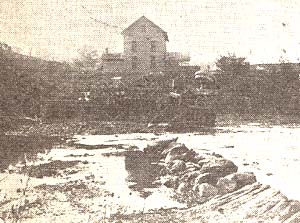
COULTER'S MILL
Showing old dam, also old water wheel which furnished power for
grinding. The mill was owned by the Coulter
family for more than forty years. The land was bought by
William Coulter from a man named Garrett in 1874, and
Mr. Coulter proceeded to erect a mill. It was a three
story building, run at first by water power. Years afterwards
the mill was moved to higher ground, as its timbers were rotting
away. After the change, gasoline power was used. Mr.
Coulter ran the mill for thirty-three years, then moved to
Oklahoma, and his son-in-law, Simon Mayberry, continued to run it
until 1913. The mill was designed for wheat grinding, but
afterwards ground mostly corn and buckwheat. T. A. Gooch
bought the place in 1914. Mr. Coulter died in Guymon,
Okla., in 1912. COLLEGE HILL If you went to see
the circus in the early days of Decatur, you usually went to the
Mound, called College hill, the present site of the A. E. Staley
and C. E. England homes. Before any homes were built on
that hill, the summit of it was much higher than it is today.
Considerable ground was taken off when the houses were erected.
For many years the hill was used as public property. There the
Civil war companies met to organize. Children used it for a
playground. Once a big tabernacle was erected for the state
Sunday school convention. At one time Rev. William S. Crissey
had made an attempt to secure a college in Decatur. and he offered
the Mound as the site for it. The effort to secure the
institution failed. Provision was made in the offer of Rev.
Mr. Crissey that buildings be erected within ten years.
No one was particularly interested in the idea and the aground was
not considered a very desirable site, so the offer went unheeded.
Rev. Mr. Crissey had laid out the square about 1840. After
the effort to get a school established had failed, Rev. Mr.
Crissey bequeathed the property to the Missionary society of the
Methodist Episcopal church of Illinois. There was no such
society, and the property reverted to the heirs. It was this
effort to start a college which gave the hill the name of College
hill. The houses on the hill were erected in the early '80s by
William B. Chambers and William J. Quinlan, both
members of the firm of Chambers, Bering & Quinlan.
The finest of wood was used in the houses and they were well built.
The Quinlan house cost $28,000. These two houses were
among the best and handsomest in the city at the time they were
erected. Today, after being remodeled and improved, the same
can be said of them. The Quinlan home was sold in 1891 to
William H. Ennis who lived there some years. In 1913 it
was bought by A. E. Staley, the present occupant. The
Chambers home was sold about 1886 to Silas Packard,
who lived there until his death. Afterwards, in 1915, the
property was bought by J. T. Whitley, who in turn sold it to
the present owner, C. E. England. IMBODEN
SPRINGS In the early '60s John Imboden bought a tract of
twelve acres south and west of the old square, and built a slaughter
house thereon. It was necessary to have water and so he hired
a well digger to dig him a well. The digging for the well had
progressed to a depth of 30 feet without striking anything out of
the ordinary. One evening the well diggers knocked off work as
usual. The next morning when they went to work they were
surprised to find that the well was not only full of water but was
furnishing a small river which was pouring down over the hill. The
order reminded people of a match factory and one bystander suggested
that probably by some means the diggers had tapped the claim of his
Satanic majesty. Mr. Imboden did some thinking right then
and there. As a result he built a reservoir at the lower end
of the place, walled it with rock and then laid a pipe line from the
well to the place, and the work of "healing the sick and the
afflicted" began. There was mineral in the water, and many
people thought they were benefited by it. Mr. Imboden
did not commercialize the place, however. It was open to
everyone and free. Another idea was presented to Mr. Imboden's
mind, that of having a skating rink in the winter. He built a
dam across a ravine in the hollow and soon had a lake. It
became very popular as a skating rink among the young folks of the
city. A bath house also was erected and mineral baths were
advertised, but, boo-oo-- the water was too cold to make that
popular. The spring remained many years, though its popularity
waned. After Mr. Imboden's death the land was platted
and sold, and when streets were graded the spring was covered up.
It burst out again when a sewer was being laid, making trouble
for the workmen, but concrete work put a final stop to the flow of
water. The spring was in use as late as 1900. It was south
of the west end of Spring street, off of Greenwood avenue.
<PREVIOUS>
<NEXT>
|